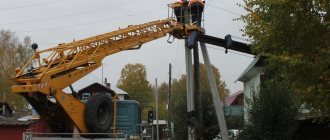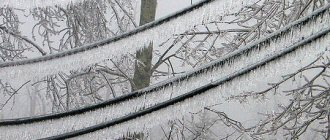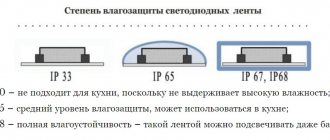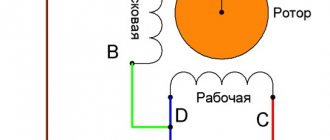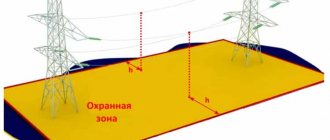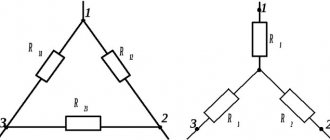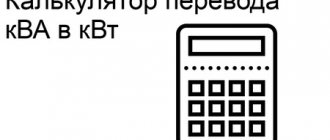The security zone of the power transmission line determines the restrictions set forth in regulations for activities in its area. First of all, the prohibitions are aimed at protecting a person from the magnetic fields of a conductor. The boundaries of spaces with a special regime around cable lines depend on the power of these objects, voltage class, purpose (power or communications), and location of installation. There are no infringements of property rights, but there are restrictions on construction, excavation work, and other actions, violation of which is fraught with fines and restitution (reduction to the previous form, for example, demolition of buildings).
The importance of protection from electromagnetic fields
Powerful voltage and currents of power lines provoke electromagnetic fields. Short-term exposure is not harmful, but continued exposure can critically impair the functioning of the body. First of all, the influence is expressed in the incorrect activity of the nervous system. Migraines, headaches, dizziness, sleep disturbances, and constant fatigue are observed. Separately, it should be noted the danger for pregnant women - the risk of incorrect fetal development increases. Particularly long-term exposure leads to cancer.
Foreign studies prove the impact of magnetic induction fluxes measured in Tesla. There are no domestic standards for this value, but according to foreign sources, the normal level of this phenomenon for people is 0.2–0.3 µT; on power lines it is much higher.
It is important for all owners and users of areas with power lines to know the safe distances from the lines to preserve their health.
The security zone of communication lines located on private or other lands is intended to prevent damage to cables and interference.
Safety and health hazards
Maintaining a safe distance from power lines and the basic rules for being in the security zone will help preserve the life and health of people, as well as property that may be damaged as a result of a fire.
The negative impact of strong electromagnetic fields generated near power lines on human health has long been established. In our country, since 1984, SanPiN 2971-84 “Sanitary standards and rules for protecting the population from the effects of electric fields created by overhead lines” has been in force. It talks about different types of influence:
- About the direct impact of being in the electric field zone, which increases with the duration of stay.
- About the impact of current pulses when a person touches objects (structures, machines), plants.
- About the impact of drainage current passing through people.
It is also noted that there is always a threat that the electric field can contribute to a fire, explosion of fuel vapors, mixtures from electrical discharges.
Consequences of exposure to electromagnetic fields on the human body
Invisible to the eye, intangible fluctuations of electric fields act on people like radiation. Under its influence, almost all systems in the human body suffer and are destroyed:
- Deterioration in the passage of nerve signals from the brain to other organs dulls reflexes and impairs coordination.
- Electromagnetic radiation can lead to blockage of blood vessels due to the clumping of blood cells. Blood pressure rises, arrhythmia begins.
- The permeability of cell membranes decreases, which leads to oxygen starvation of the body.
- Immunity decreases.
- The risk of cancer is growing.
- Sexual function decreases.
- There is a disruption in the production of hormones.
- Pregnant women with such exposure experience miscarriages and stillbirths. A child is born with various pathologies.
Read also: Violation of sanitary standards in residential premises of apartment buildings: SanPiN, hygienic living conditions, requirements and rules
How are power line zones regulated?
Regulatory sources:
- GOST 12.1.051-90 (hereinafter referred to as “GOST”). Main document. Contains, in particular, concepts, installation rules, parameters of security zones, distances, safety of work in the presence of electromagnetic fields, restrictions;
- Government resolutions N 160 (02/24/2009) and N 1033 (11/18/2013): the establishment procedure, specify the interaction, coordination of work with the companies operating the lines. More specifically, the distances and permitted manipulations are given;
- SanPiN 2.2.1/2.1.1.1200-03 and 2.1.2.2645 (SanPiN 2.1.2.1002-00, 2971-84 are not valid), development is regulated;
- Town planning, Land codes.
- via communication lines and fiber optic lines: main acts: resolution N 578 (procedure for establishing zones), SanPiN 2.1.8/2.2.4.1383-03;
- Federal Law “On Communications” (Article 10 only);
- Federal Law “On Cadastre” (registration of zones).
The provisions of GOST concern security segments, they prescribe safe clearances from live parts with 1000 V and above. For special personnel, work rules are also established by internal acts on electrical safety, PUE.
Confiscation is not carried out, that is, the security zone of electrical networks located in private ownership does not affect the right of ownership itself, but affects other rights, namely use (Article 56 of the Land Code of the Russian Federation). A special status is introduced that restricts activities that violate the objectives of the zones. Such infringements are introduced by acts of local self-government and judicial ones.
The concept of security zones of power lines
Power transmission line security zones are conventional planes, spaces (segments, sections) along and around power lines with boundaries established by standards.
The goals are to limit:
- a person being near power lines due to the harmful effects of electromagnetic fields on health, the risk of electric shock;
- activities that could damage the power lines themselves.
The area in question is the space from the power line to the ground with the specified width. That is, this is an area with an increased danger to human health, limited by conventional planes vertically, on the left, on the right. The boundaries are measured not from the cables themselves, but according to GOST rules, since they depend on the radiation power and specific technical requirements.
According to SanPiN 2.2.1/2.1.1.1200-03, the areas in question near overhead power lines (OHL) belong to one of the types of sanitary protection zones (SPZ), called sanitary breaks.
There are not only territories with a special regime for power lines: the security zone of communication lines also implies a protective status with restrictions on use.
PUE requirements
According to the requirements of PES-7, the closest possible access (no further than 500 meters from the line) must be provided to the protective territory of the power line at any time of the year; driveways must be made along the zone itself, allowing movement along the power line when carrying out various types of work (scheduled repairs and emergencies caused by abnormal situations).
Lines passing through lands crossed by reclamation canals must be equipped with overhead pedestrian decks made of concrete slabs. The width of such bridges should be at least 0.8-1.0 meters.
How to establish a power line zone
Security zones are formed at all facilities in the electrical grid sector in accordance with the requirements of regulations regarding the boundaries of such spaces. The sizes are determined by network organizations or other owners of such infrastructure and equipment.
Rules for establishing security zones:
- The network enterprise submits documents to the energy supervision authority to authorize the allocation with a detailed description of the parameters. The decision is made within 15 days;
- government agency for 5 days. sends documents to the cadastre. The allocation is considered completed from the date of updating the cadastral registration, which also displays information about the applicant and the responsible company.
Width along overhead, underground, over water lines
Rules for the width of zones along the infrastructure:
- security zone of high-voltage overhead power lines (all distances are measured from the outermost wires): space above the ground with parallel vertical frames spaced horizontally according to Table 1 of GOST, determined by voltage (kV);
- over bodies of water. Above-water space with parallel vertical boundaries on the sides. For navigable objects - 100 m. For non-navigable objects - according to the table. 1;
According to SanPiN 2.2.1/2.1.1.1200-03 (clause 3.3), the parameters of sanitary ruptures for overhead lines are as follows:
Gaps can be corrected based on the results of instrumental examinations, as well as if there are devices to reduce the electric field strength. Resolution N 160 clarifies the distances, in particular, prescribes the intervals for 1–20 kV:
The dimensions are determined using tables, for example, the security zones of 6 kV power lines are 10 or 5 m wide.
What activities are prohibited
In the protected area of the most common overhead power lines, the following is prohibited:
- Construction of capital structures;
- Storage of waste, construction, fuels and lubricants;
- Arrangement of playgrounds, retail facilities, parking lots, cattle pens;
- Lighting fires;
- Dry grass has fallen;
- Reclamation, as well as mining and blasting works;
- Planting and cutting down trees and shrubs;
- Passage of vessels whose distance from the highest point of the cargo or structure to the lowest point of the sagging wire is less than the minimum permissible value.
- Passage of machines and mechanisms with a height of more than 4.5 meters;
- Excavation work at a depth of more than 30 cm on uncultivated lands and 45 cm meters on arable lands;
- Watering crops with a stream of water more than 3 meters;
- Field agricultural work using machines and equipment whose height exceeds 4 meters.
What is prohibited in the protective territory of power lines
In the protected territory of underground cable communication lines or power transmission lines, there is one significant limitation - in such places any excavation work is prohibited (leveling, deep plowing, laying closed drainage, digging reclamation canals).
Type of power line and voltage, how to determine visually
What voltage is in the power line, and accordingly, what are the parameters of the zone, will be found out at the local power supply. You can roughly determine the characteristics by analyzing the appearance of the high-voltage line. Security zone of 10 kV and 0.4 kV power lines are the most common in populated areas.
These overhead lines are usually located in cities, equipped with SIP or aluminum wire on relatively low supports with oversized insulators - white, brown, glass (transparent). Overhead lines with 10 kV and more are equipped with large insulators, often they are brown ceramic, the height of the support is about 9 m. Lines with 0.4 kW also have a security gap, but much smaller, up to 2 m.
“Aerial towers” of 35–750 kV and more are the highest and largest supports, usually located on the outskirts of populated areas. In the forests, special clearings are cut down for them, with a width equal to the protective zones, however, as well as for other types of power lines. Towers for 35, 110, 220 kV are equipped with one core per phase, and then, according to power options, respectively, 300 - 2, 500 - 3, 750 - 4 or 5. Insulating garlands differ in the number of “plates”: 35 kV - 3 or 5 pcs., 110 - 6 or 8, 220 - 10 or 15, 500 and 750 - from 20.
Rules for work in protected zones
Permitted construction and installation work is usually only those that relate to the maintenance of supports and are carried out by special personnel. Such activities in areas with special regimes must be controlled by a responsible person, subject to compliance with electrical safety requirements in accordance with GOST 12.1.019. If it is impossible to comply with these, then work begins after the tension is removed.
Minimum safety measures: before starting, instructions are required, personnel are given protective equipment (insulator gloves, etc.), protective fences are installed, and workplaces are isolated. If the risk of touching current-carrying parts is increased, then protective grounding and grounding are provided. The insulation resistance is measured with special instruments to determine its sufficiency. The responsible person has the right to check the staff’s knowledge of basic safety rules and instructions.
If the work affects the ground or soil, then make sure that there are no underground high-voltage lines. Damage to cables by an excavator is a traditional phenomenon. If current enters the equipment, it may fail, but the main danger is the risk to the life of the excavator operator himself.
Construction on a territory with a special regime must be coordinated with the network company. If the owner has already built a house and they are planning a high-voltage installation through the adjacent territory, then such actions are coordinated with him, and coercion in the form of a court decision is possible, but the network company is always obliged to compensate for the inconvenience.
If work is carried out on overhead lines and contact with conductors is not required (there is no such contact during manipulation), the gap from a person to the closest conductor should be at least 2 m.
It is generally accepted that the distance from the pointer crane, from any part of it, of the lifted load is at least 20 m, optimally 30 m to the nearest wire. But the gap may be smaller depending on the line voltage: there are tables compiled on the basis of regulations. The crane operator must be issued a work permit, which is possible only after instructions.
Is it possible to eat vegetables and fruits grown near a high-voltage line?
Oddly enough, scientists claim that electromagnetic radiation can significantly improve the growth of all plants. At the same time, there is no residual radiation left in the harvest obtained at the dacha - it has a negative effect only on living beings. Therefore, you can grow large and beautiful vegetables and fruits, however, if you are able to care for them due to poor health. By the way, bees and other insects try to leave the danger zone near high-voltage lines.
An acquaintance of mine who works in a real estate agency told a funny story about how his former clients came to him with a complaint that because of the mobile operator tower built nearby, bees and wasps had disappeared from their area due to electromagnetic radiation. As it turned out later, the tower had not even been put into operation yet.
What is prohibited in power transmission line protection zones
Within the boundaries of the protective and sanitary space, actions that threaten the normal operation, the stability of the operation of lines, during which a danger is created for people, for the operability of the facility, or the possibility of fires, are strictly prohibited.
Directly prohibited work in the security zone of power lines (we will indicate the general list according to GOST; in R. III of Resolution 160 it is more detailed):
- placement of objects with fuels and lubricants, flammable liquids, flammable liquids;
- landfills;
- events related to explosions;
- starting a fire;
- discharge, discharge of caustic, corrosive mixtures, fuels and lubricants;
- throwing, approaching objects to supports, wires;
- you cannot climb on structures;
- any actions and stay in a segment with a special regime during thunderstorms or extreme weather.
What is prohibited without the consent of the service organization (work is highlighted separately as such, which is possible, but with the consent of the responsible enterprises, according to Resolution No. 160, paragraph 10):
- construction and installation activities, watering, planting, cutting down, as well as storing feed, fuel, etc. It is forbidden to develop roads for vehicles and machinery with a height exceeding 4.5 m;
- if the installation is underground, then excavation work and leveling using earth-moving equipment are prohibited;
- For underwater lines, activities affecting the bottom soil, arrangement of berths, movement with loose anchors, trawls, etc. are prohibited. Watering places and the allocation of fishing areas are prohibited;
- for overhead power lines, work with lifting and retractable structures is permitted if the gap from the housing, transforming segments, and objects being lifted to the closest wire is not less than according to table. 2 GOST.
Irrigation works
In GOST, irrigation works are highlighted as separate points, since they pose an immediate danger due to the increased conductive properties of water in any of its forms (splashes and even sprayed small drops). Such activities are permissible in any weather, if the stream is outside the protected space, and also if it enters it, but does not rise above 3 m from the ground.
What requirements are met for safety in the power line area?
You cannot approach a lying wire at a close distance: the voltage on high-voltage supports is sufficient to create an electric arc, so the optimal safe distance is large - from 8 m. A shorter distance does not necessarily mean electric shock, but it is highly advisable to leave the place as quickly as possible. In this case, the steps should be small, the feet should be tried not to be lifted off the ground, which will eliminate the so-called step tension, which can be critical for health.
If you find very sagging cables, you should not move in their direction and should not cross them. The design of the overhead line support is designed to hold them at a certain distance from the surface, taking into account voltage, current, and other parameters. If this clearance is compromised, there is obviously a risk of hazards occurring near the ground. If the wire is very slack, then electric shocks and arcing cannot be ruled out. A short-term last phenomenon and sparking are signs of a life-threatening emergency; you should stay away from such areas. Before crossing the zone, it is recommended to visually check the absence of the listed circumstances.
Field and voltage limits
The maximum degree of electromagnetic fields (EMF) for the population is prescribed in SanPiN 2.1.2.2645 (R. VI):
- weakening of the geomagnetic field in residential buildings - 1.5;
- electrostatic strength - 15 kV/m;
- within the boundaries of populated areas - alternating electric field strength with 50 Hz at a height of 2 m - 1000 V/m, inside residential buildings at a height of 50 cm - 2 m - 500 V/m. The range is given in appendix. 7;
- The EMF range for 30 kHz - 300 GHz is in the table. 6.
Work prior to tree felling
Before felling begins, the feller inspects from several sides the part of the cutting area where the trees will be felled, and establishes the direction of natural gravity for the fall of each tree, after which he determines the sequence of felling the trees of this group so as not to form a blockage. If the arrow F denotes the direction and magnitude of the gravitational force (Fig. 1, a) of the tree to fall as a result of tilting, and the arrow F denotes the direction and magnitude of the force arising due to the asymmetry of the crown, then the direction of the natural gravitational force of the tree to fall F is determined by the diagonal of the parallelogram constructed on forces F and F. Without much effort, a tree can be felled either to the left by 90° (to the line 0 - 1) or to the right by 90° (to the line 0 - 2). If the direction of the felling crosses the line (1-0-2), then the required force to fell tree B will be directly proportional to the magnitude of the angle of gravity to the fall. At =180° the pushing force of tree B will be greatest
Fig.1.
Choosing the direction of felling a tree a - determining the direction of natural gravity for the tree to fall (F - gravity for falling due to tilt; F - gravity for falling due to the asymmetry of the crown); b - dependence of the magnitude of the pushing force B on the direction of tree felling B of natural gravity towards falling F When choosing the direction of tree felling, it is necessary to ensure that the fallen trees are placed evenly without blockages. Such a fall of trees creates the necessary conditions for the work of cutting branches and skidding the forest. When skidding trees with the butts forward, you should not overlap the butts of some trees with the tops of others. Fallen trees should be parallel to each other with their tops pointing in the same direction. Trees are felled in groups of 5-10 pieces, based on the trip load on the tractor when skidding trees with crowns. Numbers 1 - 24 indicate the order of tree felling
Fig.2. Tree felling order
Before you start felling a tree, you should prepare the workplace accordingly: remove dry branches; cut down bushes around the tree at a distance of at least 1-1.5 m; cut down low-hanging branches that interfere with work from the tree; cut paths 4 - 6 m long on the side opposite to the cut at an angle of 45° to the plane of the felling. When felling a forest in winter, you need to clear the snow around the tree within a radius of at least the saw holder. Next, it is necessary to debark the stumps of coniferous trees and cut off the root nodules, which makes it possible to leave lower stumps and contributes to less dulling of saws
Fig.3. Sequence of tree felling Scheme of workplace preparation (B - direction of tree felling)
Security zones of communication lines
Communication lines include linear cable objects, communication objects, signal transmission objects, and physical circuits. Federal Law “On Communications” (Article 10) states that the establishment of protective zones and the creation of clearings is regulated by land legislation, and the main provisions are spelled out in Government Decree N 578 and SanPiN 2.1.8/2.2.4.1383-03
The security zone of communication lines has how many meters:
- for infrastructure, underground communications and overhead lines, radio installations - lengthwise segments with a width of 2 m;
- for marine laying and for communications through navigable, raftable water bodies - segments to the bottom, spaced 0.25 nautical. miles on the sides or when crossing water bodies - by 100 m;
- for autonomous structures to increase the signal, with regeneration functions - segments with a closed boundary with a width from the center of the equipment or from the embankment of at least 3 m and from the grounding contours of at least 2 m.
What is prohibited
The security zone of communication lines established by law prohibits, without the written consent and presence of representatives of operating institutions:
- installation, construction, blasting work, as well as soil leveling with digging equipment (except for areas with sand dunes) and earthworks (except for plowing to a depth not exceeding 0.3 m);
- activities: geological surveys related to prospecting, geodesy and other survey activities involving drilling, trenching, and sampling;
- planting trees, placing field camps, keeping livestock, storage, fires, shooting ranges;
- driveways, parking lots;
- transportation of goods under wires;
- arrangement of canals (aryks);
- barriers, obstacles;
- berths, unloading and loading operations;
- underwater technical, dredging, dredging work;
- allocation of fishing grounds, extraction of fish, other aquatic life, vegetation with benthic devices;
- watering places, splitting, ice making;
- you cannot drop anchors, passages with dropped anchors, chains, trawls, etc. are prohibited;
- any construction or reconstruction activities related to lines;
- protection of underground communications without taking into account underground installations;
- It is forbidden to move signs or infrastructure structures during construction work.
It should be emphasized that the security zone of communication lines allows the placement of the above, but only with the consent of the responsible company.
Actions that threaten the operation of communication lines and radio installations are strictly prohibited, for example:
- reconstruction, demolition of buildings, bridges, reconstruction of collectors, tunnels, infrastructure where cables and related objects are laid (poles, technical structures, etc.) without prior removal of lines with the permission of service companies;
- backfilling of highways, arrangement of permanent warehouses on them, as well as drains and landfills;
- break any signs, fencing structures, telephone wells;
- open hatches and doors of communications and infrastructure facilities (wells, boxes, etc.);
- install fences to prevent access for technical personnel;
- other actions that create a risk of damage to communication lines and associated objects;
- It is prohibited to fill the hatches of wells, cabinets, signs, fences and similar objects with garbage and earth.
If excavation of the soil is allowed by the service company, then it is carried out only with shovels without sharp impacts (with the exception of plowing at 0.3 m). Do not use impact devices (crowbars, picks, pneumatic devices).
With whom and how to coordinate work
The interaction with enterprises in whose jurisdiction the communication lines are located, obtaining permits and coordinating work is reflected in detail in Resolution No. 578. For power lines, such a document is Resolution No. 160. The general rules are contained in other documents indicated by us at the beginning of the article.
In all cases, during planned line maintenance work, the owner of the site is warned in writing by the responsible enterprise.
Coordination for work in communication line areas
The parameters of areas where work and tree planting are prohibited are determined by operating organizations. The boundaries and location of communication lines are created by them and agreed upon with local government (administrations) according to previously drawn up projects.
If there are security zones on plots allocated for agriculture, vegetable gardens, orchards, a note is made in the documents for such lands about the presence of segments with a special regime. The allocation of such plots is carried out by local governments in agreement with the companies operating the lines, which also inform the owner of the plot in writing about the described feature, and also determine the compensation associated with this.
For work carried out by the owner (user) of the site, the written consent of the enterprise responsible for the lines must be obtained (R. III post. N 160). Moreover, such a document must also be obtained from special supervision and control authorities for measures to identify the location of underground communications.
A developer intending to work in the zone no later than 3 days in advance. (working days) before the start of the event, he is obliged to call the responsible employee of the service company to accurately determine the location of the cables. Based on the results of the analysis, a report is drawn up. The line is marked with poles and signs. Workers are familiarized with the hazard data and the information received. Developers notify the responsible company about the start of activities no later than 3 days in advance. Work is prohibited until a representative arrives at the site.
The enterprise is obliged to compensate land owners for losses associated with the maintenance of communication lines and power lines.
Coordination of work in security zones of power lines
To approve work in the security zone of an overhead line or another type (underground, underwater), interested parties submit an application to the network organization no later than 15 working days. days The latter is obliged to consider the application within two days and make a decision on approval. The application must be accompanied by a project, technical documentation (mandatory for blasting activities) and a description of the work.
Types of hems and their implementation
Fig.4.
Normal or straight cutting When direct cutting, the following conditions must be met: the height of the stump from the neck of the root should be no more than 1/3 of the diameter if the diameter of the tree in the cutting plane is 30 cm or more, and up to 10 cm if the diameter is less than 30 cm. If the lateral roots do not protrude above the ground surface, the height of the stump is calculated from the level of the soil surface
Fig.5. Simplified undercut - undercut a - scheme for applying cuts; b - snatched fibers on a stump after felling a tree with unfinished wood left behind; c - damaged butt part
With a simplified undercut - undercut, one cut is made on the trunk. Cutting down a tree with a simplified cut can be done with or without leaving the undercut. When cutting down a tree without leaving any undercut, the distance b between cuts must be such that the shearing resistance along the fibers along the line dl is greater than the weight of the tree. The thicker and heavier the tree, especially if there is even a slight wind in the direction the tree is falling, the height b of the shearing plane should be greater. If these rules are not followed, the fibers along line dl will break and the tree will sag before the saw bar is removed from the cut. If the crown is asymmetrical, even if the specified conditions are met, the tree will certainly begin to turn at the beginning of the fall and the direction of the fall will be disrupted, and if the distance b between cuts is small, the butt of the tree may slide towards the minder. When leaving undercut in the tree, the distance between cuts can be small, since the fibers of the undercut can withstand large tensile forces. Leaving a larger undercut can lead to snatches and large losses of wood
Fig.6. Oblique undercut (undercut) a - the shape of the stump and butt of a tree; b - the phenomenon of rotation of a tree when falling
With an oblique hem, the tree rotates around its longitudinal axis as it falls. The greater the slope of the oblique cut (along line ab) to the horizontal, the more the tree deviates when falling from a given direction, which increases the likelihood of blockages in the clearing. When felling trees with an oblique cut, the butts are high, which leads to large losses of wood
Fig.7. Undercut with a mustache: a - formation of a chip on a stump after cutting down a tree
The bevel cut is used for felling heavily inclined trees. The location of the lower cheeks of the undercut at an angle prevents the wedge-shaped visor of the tree from sliding off the stump to the side, which ensures safe work. However, cutting with a mustache is labor-intensive and leads to the formation of high stumps on the route
Fig.8. Undercut with a mustache: the butt part of a sawn tree with a visor
The shearing area is equal to the area dlQq. There are very few uncut fibers left in the udq plane. The top edge of the hem almost does not converge with the bottom until the very end of the fall of the tree. Thus, uncut fibers only work on bending without stretching, which protects the butt from splitting
Fig.9. Undercut with two parallel cuts
Undercutting (undercutting) with two parallel cuts makes it possible to replace undercuts made with an ax by filing. The dimensions of the undercut and the stump left with this method are the same as with a direct normal undercut. With this method of cutting, the fallen tree may not have a canopy. Felling thick trees with one-sided or highly developed crowns is dangerous, since cases of the butt slipping towards the feller cannot be ruled out
Bottom line
Construction in the protected zone and other work are prohibited conditionally, that is, possible with the consent of the company under whose jurisdiction this infrastructure is located. But there are also strictly prohibited events.
When analyzing information, an interested person must definitely read the regulatory documents we indicated at the beginning of the article, and especially Resolutions 160, 1033, 578, which more specifically provide lists of what is prohibited, what is allowed and in what cases, depending on the parameters of the lines. It should be noted that there are different rules: there are direct prohibitions and conditional ones (work is possible with the consent of the responsible companies), for lines of different power (up to 1000 V and above), for underground, underwater, and air communications.
